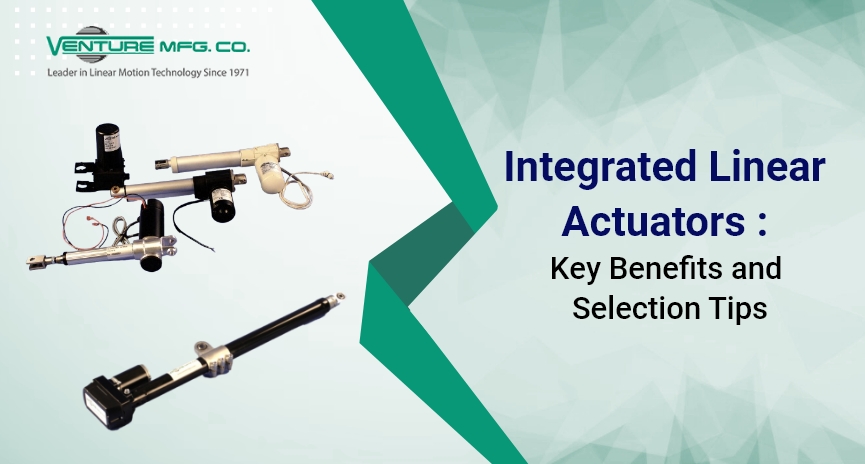
Integrated linear actuators combine motors, sensors, and controllers into a single, compact assembly, providing an efficient solution for motion control. Unlike standard actuators, integrated linear actuators eliminate the need for external control systems, reducing complexity, saving space, and improving performance. This integration enhances precision and energy efficiency, making them crucial in industries such as automation, robotics, and medical devices. Integrated actuators deliver superior control, smoother operation, and faster installation than traditional models. This post explores how integrated linear actuators seamlessly fit into existing systems, offering a comparison with standard linear actuators, highlighting their advantages, and providing guidance on selecting the right integrated actuator for specific applications.
How Integrated Linear Actuators Work in Existing Systems?
Integrated linear actuators work by converting electrical energy into linear motion, and they can be seamlessly integrated into existing systems by matching key parameters like load capacity, speed, and stroke length with the application requirements. Here, it is important to understand the sizing of a linear actuator. Sizing an actuator involves evaluating factors such as the required force, desired speed, duty cycle, and space constraints. Proper integration also considers compatibility with control systems, ensuring that the actuator’s feedback options such as potentiometers or encoders align with the system’s automation needs, enhancing precision and efficiency. Careful actuator selection optimizes system performance while avoiding overloading or underperformance.
Compare Integrated Linear Actuators and Standard Actuators
Standard actuators and integrated linear actuators are both important in automating processes in different industries. However, each has its unique features and benefits depending on the application. Below is a comparison to highlight the differences between the two.
| Feature | Integrated Linear Actuators | Standard Actuators |
| Design | Combines motor, drive, and actuator in one unit | Separate components: actuator, motor, and controller |
| Ease of Installation | Easy to install with fewer components | Requires multiple components, increasing installation time |
| Maintenance | Low maintenance due to fewer parts | Higher maintenance with more components to manage |
| Size | Compact, ideal for limited space | Large, depending on the size of the components |
| Cost | Higher initial cost, but long-term savings in integration | Lower initial cost, but high costs for full system integration |
| Applications | Best for compact automation setups | Suitable for larger or more complex systems |
| Customization | Limited customization due to integrated design | High flexibility and customization options |
Advantages of Integrated Linear Actuators
Due to their efficiency and versatility, integrated linear actuators are becoming a popular choice across industries. These systems combine multiple components into a single streamlined unit, providing numerous benefits that enhance both performance and reliability. Here are some of the key advantages.
- Compact Design: Integrated linear actuators save space by combining all the required parts in a single unit. There is no need to install individual parts, such as motor, controller, and actuator. This is especially beneficial in applications with limited space.
- Simplified Installation: Integrated actuators require fewer parts. Hence, one can reduce the complexity of installation and maintenance. The installation is faster, resulting in lower labor costs.
- High Precision: Actuators facilitate precise and repeatable motion. Therefore, they are ideal automation systems and robotics must be carried out with great precision.
- Less Wiring and Cabling: Integrated actuators have their components housed within the same unit. Consequently, there is much less wiring, which can cause the system to become less complicated and reduce the potential points of failure as well.
- Energy Efficiency: Optimization in internal design often results in less power usage from integrated linear actuators than the traditional ones, which might mean fewer costlier issues in the long run.
- Increased Durability: Integrated systems are more likely to be robust or reliable as they are designed to work together as an integrated unit, rather than in isolation, thereby reducing wear and tear within different parts.
Related Blog – Electric Linear Actuators Help Manufacturing Industries to be Better and Faster
How to Choose the Right Integrated Linear Actuators?
Choosing the right integrated linear actuator is crucial for ensuring efficiency and performance in various applications, from automation systems to robotics. The process involves considering several key factors that align with the specific needs of your project.
- Load Capacity: Determine the weight or force the actuator must move with. Choose an actuator that can handle the maximum load with a margin for safety.
- Stroke Length: This refers to how far the actuator needs to extend or retract. Measure the required range of motion and select an actuator that fits these specifications.
- Speed Requirements: Depending on the application, you may need high-speed movements or more controlled, slower operations. Actuators vary in speed, so consider this aspect carefully.
- Precision and Accuracy: Some applications demand exact positioning. Opt for actuators with high-resolution feedback systems or integrated encoders if precision is critical,
- Environment: Consider the operating environment, including temperature, humidity, or exposure to dust and moisture. Choose an actuator and the enclosure with appropriate ingress protection (IP) ratings.
- Power Source: Understand whether the actuator requires an electric, hydraulic, or pneumatic power source, and ensure compatibility with your system. For most applications, electric actuators work well.
Are you looking for ways to improve your machine design and performance? At Venture Manufacturing, we offer high-quality integrated linear actuators that provide precision, reliability, and efficiency for your applications. Our actuators are designed to optimize your system’s functionality while minimizing maintenance expenses. If you have any questions or specific needs, contact our sales team today for customized solutions catering to your unique requirements.
